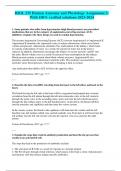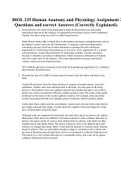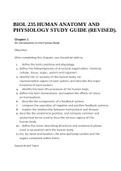Athabasca University (AU ) • BIOL 235 HUMAN ANATOMY AND PHYSIOLOGY
Latest uploads for BIOL 235 HUMAN ANATOMY AND PHYSIOLOGY at Athabasca University (AU ). Looking for BIOL 235 HUMAN ANATOMY AND PHYSIOLOGY notes at Athabasca University (AU )? We have lots of notes, study guides and study notes available for BIOL 235 HUMAN ANATOMY AND PHYSIOLOGY at Athabasca University (AU ).
-
12
- 0
-
3
Courses BIOL 235 HUMAN ANATOMY AND PHYSIOLOGY at Athabasca University (AU )
Notes available for the following courses of BIOL 235 HUMAN ANATOMY AND PHYSIOLOGY at Athabasca University (AU )
-
BIOL 235 BIOL235 11
-
BIOL235 BIOL235 1
Latest notes & summaries Athabasca University (AU ) • BIOL 235 HUMAN ANATOMY AND PHYSIOLOGY

This is a detailed summary of the entire human anatomy and physiology course (29 chapters). The notes for the first few chapters are formatted as questions and answers, and the rest of the chapters are detailed notes with pictures. The entire course is outlined in these notes! They cover all organ systems of the human body in detail, as well as the structures and functions of cells and the basic building blocks of life. It also covers metabolism, acid-base fluid balance, developmental biology, a...
- Class notes
- • 0 pages's •
-
Athabasca University•BIOL 235
Preview 1 out of 0 pages
This is a detailed summary of the entire human anatomy and physiology course (29 chapters). The notes for the first few chapters are formatted as questions and answers, and the rest of the chapters are detailed notes with pictures. The entire course is outlined in these notes! They cover all organ systems of the human body in detail, as well as the structures and functions of cells and the basic building blocks of life. It also covers metabolism, acid-base fluid balance, developmental biology, a...

BIOL 235 Human Anatomy and Physiology Assignment 3-With 100% verified solutions-2023-2024
- Exam (elaborations)
- • 13 pages's •
-
Athabasca University•BIOL 235
Preview 2 out of 13 pages
BIOL 235 Human Anatomy and Physiology Assignment 3-With 100% verified solutions-2023-2024

BIOL 235 Human Anatomy and Physiology Assignment 3-With 100% verified solutions-2023-2024
- Exam (elaborations)
- • 13 pages's •
-
Athabasca University•BIOL 235
Preview 2 out of 13 pages
BIOL 235 Human Anatomy and Physiology Assignment 3-With 100% verified solutions-2023-2024

Biol 235 Sample Questions and Answers Rated A+ (Athabasca University) Test Bank. Package Title: Testbank Question type: Multiple Choice 1) Which of the following terms identifies the anatomical region found between the lungs that extends from the sternum to the vertebral column and from the first rib to the diaphragm? a) Epicardium b) Abdominal cavity c) Pericardium d) Mediastinum e) Thoracic cavity Answer: d Difficulty: Easy Study Objective 1: SO 20.1 Describe the anatomical location...
- Package deal
- Exam (elaborations)
- • 48 pages's •
-
Athabasca University•Biol 235
-
BIOL 235 Midterm Exam 2 With Complete Solution(100% Verified) 185 Questions with 100% Correct Answers, Biol 235 Sample Questions and Answers, Biol 235Test Bank (2), BIOL 235 Midterm 1 Revised Questions and Correct Answers, BIOL 235 Assignment 3 Questions• ByDoctorReinhad
Preview 4 out of 48 pages
Biol 235 Sample Questions and Answers Rated A+ (Athabasca University) Test Bank. Package Title: Testbank Question type: Multiple Choice 1) Which of the following terms identifies the anatomical region found between the lungs that extends from the sternum to the vertebral column and from the first rib to the diaphragm? a) Epicardium b) Abdominal cavity c) Pericardium d) Mediastinum e) Thoracic cavity Answer: d Difficulty: Easy Study Objective 1: SO 20.1 Describe the anatomical location...

BIOL 235 Midterm Exam 2 With Complete Solution(100% Verified) 185 Questions with 100% Correct Answers. 1. between the origin and insertion which is usually located proximally in limbs ? - Origin 2. What happens during REVERSE MUSCLE ACTION? - specific movements of the body the actions are reversed THEREFOR the positions of the origin and insertion of a muscle are switched 3. What is a mechanical advantage using the example of a lever? - if the load is closer to the fulcrum and the effort...
- Package deal
- Exam (elaborations)
- • 20 pages's •
-
Athabasca University•BIOL 235
-
BIOL 235 Midterm Exam 2 With Complete Solution(100% Verified) 185 Questions with 100% Correct Answers, Biol 235 Sample Questions and Answers, Biol 235Test Bank (2), BIOL 235 Midterm 1 Revised Questions and Correct Answers, BIOL 235 Assignment 3 Questions• ByDoctorReinhad
Preview 3 out of 20 pages
BIOL 235 Midterm Exam 2 With Complete Solution(100% Verified) 185 Questions with 100% Correct Answers. 1. between the origin and insertion which is usually located proximally in limbs ? - Origin 2. What happens during REVERSE MUSCLE ACTION? - specific movements of the body the actions are reversed THEREFOR the positions of the origin and insertion of a muscle are switched 3. What is a mechanical advantage using the example of a lever? - if the load is closer to the fulcrum and the effort...

BIOL 235 HUMAN ANATOMY AND PHYSIOLOGY STUDY GUIDE (REVISED). Chapter 1 An Introduction to the Human Body Objectives After completing this chapter, you should be able to 1. define the terms anatomy and physiology. 2. define the following levels of structural organization: chemical, cellular, tissue, organ, system and organism. 3. identify the 11 systems of the human body, list representative organs of each system, and describe the major functions of each system. 4. identify the basic l...
- Package deal
- Exam (elaborations)
- • 293 pages's •
-
Athabasca University•BIOL 235
-
BIOL 235 Midterm Exam 2 With Complete Solution(100% Verified) 185 Questions with 100% Correct Answers, Biol 235 Sample Questions and Answers, Biol 235Test Bank (2), BIOL 235 Midterm 1 Revised Questions and Correct Answers, BIOL 235 Assignment 3 Questions• ByDoctorReinhad
Preview 4 out of 293 pages
BIOL 235 HUMAN ANATOMY AND PHYSIOLOGY STUDY GUIDE (REVISED). Chapter 1 An Introduction to the Human Body Objectives After completing this chapter, you should be able to 1. define the terms anatomy and physiology. 2. define the following levels of structural organization: chemical, cellular, tissue, organ, system and organism. 3. identify the 11 systems of the human body, list representative organs of each system, and describe the major functions of each system. 4. identify the basic l...

BIOL 235 Human Anatomy and Physiology Assignment 3 Questions and correct Answers (Correctly Explained). 1. Some patients who suffer from hypertension (high blood pressure) are prescribed medications that are in the category of angiotensin-converting enzyme (ACE) inhibitors. Explain why these drugs are used to combat hypertension. When blood volume falls or blood flow to the kidneys decreases, juxtaglomerular cells in the kidneys secrete renin into the bloodstream. In sequence, renin and ang...
- Package deal
- Exam (elaborations)
- • 13 pages's •
-
Athabasca University•BIOL 235
-
BIOL 235 Midterm Exam 2 With Complete Solution(100% Verified) 185 Questions with 100% Correct Answers, Biol 235 Sample Questions and Answers, Biol 235Test Bank (2), BIOL 235 Midterm 1 Revised Questions and Correct Answers, BIOL 235 Assignment 3 Questions• ByDoctorReinhad
Preview 2 out of 13 pages
BIOL 235 Human Anatomy and Physiology Assignment 3 Questions and correct Answers (Correctly Explained). 1. Some patients who suffer from hypertension (high blood pressure) are prescribed medications that are in the category of angiotensin-converting enzyme (ACE) inhibitors. Explain why these drugs are used to combat hypertension. When blood volume falls or blood flow to the kidneys decreases, juxtaglomerular cells in the kidneys secrete renin into the bloodstream. In sequence, renin and ang...

BIOL 235 HUMAN ANATOMY AND PHYSIOLOGY STUDY GUIDE (REVISED). Chapter 1 An Introduction to the Human Body Objectives After completing this chapter, you should be able to 1. define the terms anatomy and physiology. 2. define the following levels of structural organization: chemical, cellular, tissue, organ, system and organism. 3. identify the 11 systems of the human body, list representative organs of each system, and describe the major functions of each system. 4. identify the basic l...
- Package deal
- Exam (elaborations)
- • 293 pages's •
-
Athabasca University•BIOL235
-
BIOL 235 Midterm Exam 2 185 Questions with 100% Correct Answers, Biol 235 Questions and Answers Test Bank, Biol 235 Sample Questions and Answers, BIOL 235 Midterm 1 Questions and Correct Answers, BIOL 235 EXAM STUDY GUIDE (REVISED), BIOL 235 Assignment 3• ByTutorexpert01
Preview 4 out of 293 pages
BIOL 235 HUMAN ANATOMY AND PHYSIOLOGY STUDY GUIDE (REVISED). Chapter 1 An Introduction to the Human Body Objectives After completing this chapter, you should be able to 1. define the terms anatomy and physiology. 2. define the following levels of structural organization: chemical, cellular, tissue, organ, system and organism. 3. identify the 11 systems of the human body, list representative organs of each system, and describe the major functions of each system. 4. identify the basic l...

BIOL 235 Human Anatomy and Physiology Assignment 3 Questions and correct Answers (Correctly Explained). 1. Some patients who suffer from hypertension (high blood pressure) are prescribed medications that are in the category of angiotensin-converting enzyme (ACE) inhibitors. Explain why these drugs are used to combat hypertension. When blood volume falls or blood flow to the kidneys decreases, juxtaglomerular cells in the kidneys secrete renin into the bloodstream. In sequence, renin and ang...
- Package deal
- Exam (elaborations)
- • 13 pages's •
-
Athabasca University•BIOL 235
-
BIOL 235 Midterm Exam 2 185 Questions with 100% Correct Answers, Biol 235 Questions and Answers Test Bank, Biol 235 Sample Questions and Answers, BIOL 235 Midterm 1 Questions and Correct Answers, BIOL 235 EXAM STUDY GUIDE (REVISED), BIOL 235 Assignment 3• ByTutorexpert01
Preview 2 out of 13 pages
BIOL 235 Human Anatomy and Physiology Assignment 3 Questions and correct Answers (Correctly Explained). 1. Some patients who suffer from hypertension (high blood pressure) are prescribed medications that are in the category of angiotensin-converting enzyme (ACE) inhibitors. Explain why these drugs are used to combat hypertension. When blood volume falls or blood flow to the kidneys decreases, juxtaglomerular cells in the kidneys secrete renin into the bloodstream. In sequence, renin and ang...

BIOL 235 Human Anatomy and Physiology Assignment 3 Questions and correct Answers (Correctly Explained). 1. Some patients who suffer from hypertension (high blood pressure) are prescribed medications that are in the category of angiotensin-converting enzyme (ACE) inhibitors. Explain why these drugs are used to combat hypertension. When blood volume falls or blood flow to the kidneys decreases, juxtaglomerular cells in the kidneys secrete renin into the bloodstream. In sequence, renin and ang...
- Package deal
- Exam (elaborations)
- • 13 pages's •
-
Athabasca University•BIOL 235
-
BIOL 235 Assignment 3 Questions and correct Answers, BIOL 235 EXAM STUDY GUIDE (REVISED), BIOL 235 Midterm 1 Questions and Correct Answers, BIOL 235 Midterm Exam 2 185 Questions with 100% Correct Answers, Biol 235 Sample Questions and Answers Rated A T• ByEXCELLENTNURSE
Preview 2 out of 13 pages
BIOL 235 Human Anatomy and Physiology Assignment 3 Questions and correct Answers (Correctly Explained). 1. Some patients who suffer from hypertension (high blood pressure) are prescribed medications that are in the category of angiotensin-converting enzyme (ACE) inhibitors. Explain why these drugs are used to combat hypertension. When blood volume falls or blood flow to the kidneys decreases, juxtaglomerular cells in the kidneys secrete renin into the bloodstream. In sequence, renin and ang...
